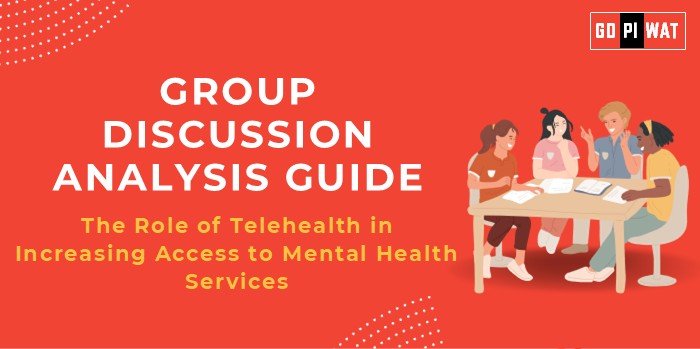📋 Group Discussion Analysis Guide: The Role of Telehealth in Increasing Access to Mental Health Services
🌐 Introduction to the Topic
📖 Opening Context
Telehealth is transforming healthcare by leveraging digital platforms to provide remote medical and mental health services. In the wake of rising mental health challenges globally, its importance has been magnified, especially in underserved regions.
📜 Topic Background
The integration of telehealth into mental health services aims to bridge the accessibility gap, offering critical interventions to rural, economically disadvantaged, or geographically isolated populations. With advancements in technology and widespread internet penetration, telehealth holds the promise of equitable mental health care.
📊 Quick Facts and Key Statistics
- 🌍 Global Telehealth Market: Valued at $87 billion in 2023, projected to grow to $380 billion by 2030.
- 🧠 Mental Health Disorders: Affects 1 in 8 people globally; telehealth reduces barriers to seeking help.
- 📱 Telehealth Penetration in Mental Health: 40% of mental health consultations in the US now occur online (2024).
- 💰 Cost Effectiveness: Telehealth reduces healthcare costs by 20-40%, particularly in mental health management.
- 🌍 Reach in Remote Areas: Telehealth programs expanded access to mental health services by 50% in rural India during COVID-19.
🤝 Stakeholders and Their Roles
- 🏛️ Governments: Implement telehealth policies, subsidize digital infrastructure, and regulate data privacy.
- 🏢 Private Health Platforms: Innovate user-friendly platforms and provide virtual consultations.
- 💼 Healthcare Providers: Adapt to telehealth systems for remote consultations and therapy.
- 👥 Patients and Communities: Embrace telehealth for accessibility while addressing digital literacy gaps.
🏆 Achievements and Challenges
✨ Achievements
- 📈 Increased Access: Telehealth services expanded mental health access in rural and underserved areas globally.
- 💰 Cost Reduction: Reduced costs for patients and healthcare systems.
- ⏱️ Flexibility and Convenience: Enabled access to therapy sessions from home, enhancing consistency.
- 🌐 COVID-19 Catalyst: Spurred a 200% increase in telehealth adoption during the pandemic.
⚠️ Challenges
- 🌐 Digital Divide: Limited access in low-income or rural areas.
- 🔒 Regulatory Gaps: Privacy and data protection remain major concerns.
- 💻 Technological Barriers: High costs of telehealth devices and platforms.
🌎 Global Comparisons
- 🇺🇸 USA: 40% mental health consultations via telehealth; strong data protection laws.
- 🇮🇳 India: Limited but growing telepsychiatry initiatives supported by the government.
📚 Case Study
📖 Tele-MANAS Program, India: Provided virtual mental health services, helping over 1 million citizens in its first year.
💡 Structured Arguments for Discussion
- 👍 Supporting Stance: “Telehealth is revolutionizing mental health care, breaking geographical barriers, and saving lives.”
- 👎 Opposing Stance: “The digital divide and lack of regulations undermine telehealth’s full potential.”
- ⚖️ Balanced Perspective: “While telehealth addresses access issues, holistic growth demands overcoming regulatory and technological challenges.”
📈 Effective Discussion Approaches
🔑 Opening Approaches
- 📊 Statistical Impact: “1 in 8 people globally struggle with mental health issues; telehealth can transform their access to care.”
- 📖 Case Study Opening: “Tele-MANAS in India demonstrated how digital platforms can provide large-scale mental health support.”
🤔 Counter-Argument Handling
- 💡 Address concerns by highlighting success stories.
- 📚 Propose hybrid solutions combining in-person and telehealth services.
🔍 Strategic Analysis of Strengths and Weaknesses
- 🌟 Strengths: Accessibility, cost efficiency, scalability.
- ⚠️ Weaknesses: Digital illiteracy, limited rural connectivity.
- 🚀 Opportunities: 5G rollout, AI-driven diagnosis tools.
- ⚡ Threats: Cybersecurity risks, uneven policy frameworks.
📚 Connecting with B-School Applications
- 🌐 Real-World Applications: Use telehealth in projects linking healthcare management and digital innovations.
- 💬 Sample Interview Questions:
- 🧠 “How can telehealth improve healthcare inclusivity?”
- 🔒 “What are the major regulatory concerns in telehealth implementation?”
- 💡 Insights for Students: Explore telehealth business models, regulatory landscapes, and patient behavior analytics.


